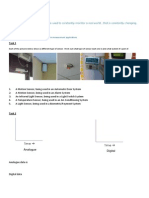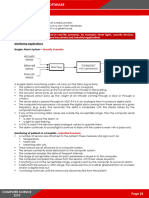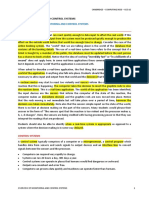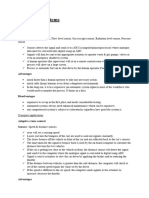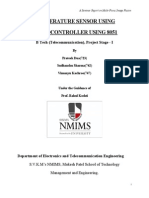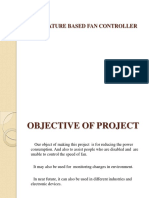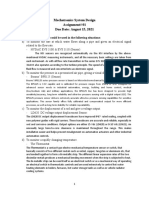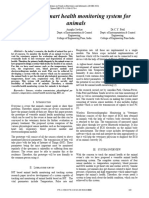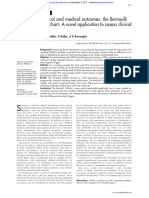INPUT
DEVICES
FOR
MID-YEAR
���� SENSORS
Sensors are devices that measure physical properties like temperature, pressure, and acidity level.
The data they provide is constantly changing and needs to be converted into digital format for
computers to use. This is done through an analogue to digital converter. Computers can use this
data to control devices like motors or valves through a digital to analogue converter. This process
is called feedback, where the output affects the next input received by the sensor. Sensors are used
for monitoring and controlling various applications.
Examples of monitoring:
Sensors can monitor a patient's vital signs like heart rate and temperature in a hospital.
Sensors can detect intruders in a burglar alarm system.
Sensors can check the temperature levels in a car engine.
Sensors can monitor pollution levels in a river.
Examples of control:
Sensors can turn streetlights on at night and off during the day
Sensors can control the temperature in heating/air conditioning systems
Sensors can help maintain the right temperature and pH levels in chemical processes
Sensors can operate anti-lock brakes on a car when necessary
Sensors can control the environment in a greenhouse.
Monitoring Applications:
Security systems:
A security monitoring system is activated by a password on a keypad.
An infrared sensor detects movement of an intruder in the building.
An acoustic sensor detects sounds like footsteps or breaking glass.
A pressure sensor detects the weight of an intruder coming through a door or window.
The sensor data is converted from analog to digital using an ADC.
The computer samples the digital data from the sensors at a given frequency.
The computer compares the data with stored values and sends a signal to a siren or light if
the data is outside the acceptable range.
A DAC is used if the devices need analog values to operate them.
The alarm continues to sound, or lights continue to flash until the system is reset with a
password.
Monitoring of patients in a hospital:
Sensors are attached to the patient to measure vital signs like temperature, heart rate, and
breathing rate.
The sensors are connected to a computer system that receives the data from the sensors.
�� The computer system samples the data at frequent intervals and compares it with the
acceptable range for each parameter.
If the data is out of range, an alarm is sounded.
If the data is within range, it is shown on a screen or digital readout.
Monitoring continues until the sensors are disconnected from the patient.
Control Applications:
Control of street lighting:
A microprocessor controls a streetlamp using a light sensor in this way:
The light sensor sends data to the ADC interface.
The ADC changes the data into digital form and sends it to the microprocessor.
The microprocessor samples the data at regular intervals.
If the data is below a certain value stored in memory, the microprocessor sends a signal to
turn the streetlamp on.
The lamp stays on for 30 minutes before the sensor readings are sampled again.
If the data is equal to or above the value stored in memory, the microprocessor sends a
signal to turn the streetlamp off.
The lamp stays off for 30 minutes before sensor readings are sampled again.
This system prevents the lamp from flickering on and off during brief cloud cover.
Anti-lock braking systems (on cars):
Anti-lock braking systems (ABS) on cars use magnetic field sensors to prevent the wheels from
locking up when the brakes are applied too sharply:
When one of the car wheels starts to lock up, a magnetic field sensor sends data to a
microprocessor.
The microprocessor checks the speed of the other wheels and compares it with the affected
wheel.
If there is a difference in speed, the microprocessor sends a signal to the braking system to
reduce the braking pressure on the affected wheel.
This allows the wheel to speed up and match the speed of the other wheels.
The rotational speed of the wheels is checked several times a second, and the braking
pressure to all the wheels can be constantly adjusted to prevent any of the wheels from
locking up under heavy braking.
This is felt as a 'judder' on the brake pedal as the braking system is constantly switched off
and on to equalize the rotational speed of all four wheels.
If one of the wheels is rotating too quickly, the braking pressure is increased on that wheel
until it matches the other three.
�Central heating systems:
A gas supply is used to heat water in a heater.
The valve on the gas supply is controlled by a microprocessor to increase the heating levels.
A water pump pumps hot water around the central heating system.
The microprocessor stores a pre-set value for the required temperature.
The temperature sensor constantly sends data readings to the microprocessor.
The microprocessor converts the analogue data into digital data using an ADC.
The microprocessor compares the temperature reading with the pre-set value.
If the temperature reading is >= pre-set value, no action is taken.
If the temperature reading is < pre-set value, a signal is sent to an actuator (via a DAC) to
open the gas valve to the heater and turn on the water pump.
The process continues until the central heating is switched off.
Chemical process control:
A chemical process requires a temperature above 70°C and a pH level less than 3.5 to work.
Sensors are used to measure temperature and pH levels of the chemical process.
The sensor data is converted to digital format using an ADC and sent to a computer for
processing.
The computer compares the incoming sensor data with pre-set values stored in its memory.
If the temperature is below 70°C, the computer sends a signal to switch on the heater.
If the temperature is equal to or above 70°C, the computer sends a signal to switch off the
heater.
If the pH level is higher than 3.5, the computer sends a signal to open a valve and add acid.
If the pH level is equal to or less than 3.5, the computer sends a signal to close the valve.
The computer signals are converted to analogue signals using a DAC to control the heaters
and valves.
This process continues as long as the computer system is activated.
Greenhouse environment control:
To control the greenhouse environment, five sensors can be used: humidity, moisture,
temperature, pH, and light.
Humidity sensor sends a signal to an ADC, which then sends a digital signal to the
computer for comparison with stored pre-set values.
If humidity is greater than the pre-set value, the computer sends a signal to a DAC to
operate the motors to open windows and reduce humidity.
If humidity is less than the pre-set value, the computer sends a signal to open valves to
spray water into the air and increase humidity.
If the humidity reading is equal to the pre-set value, no action is taken.
The control process continues as long as the system is switched on.
Similar arguments can be used for all five sensors.





















